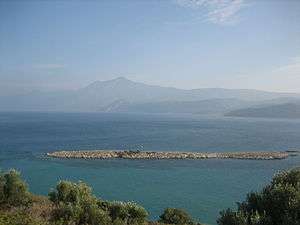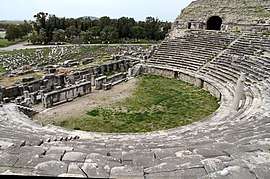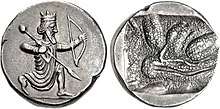Ionia
Ionia (/aɪˈoʊniə/; Ancient Greek: Ἰωνία /i.ɔː.ní.aː/, Iōnía or Ἰωνίη, Iōníē) was an ancient region on the central part of the western coast of Anatolia in present-day Turkey, the region nearest İzmir, which was historically Smyrna. It consisted of the northernmost territories of the Ionian League of Greek settlements. Never a unified state, it was named after the Ionian tribe who, in the Archaic Period (600–480 BC), settled mainly the shores and islands of the Aegean Sea. Ionian states were identified by tradition and by their use of Eastern Greek.
| Ionia (Ἰωνία) | |
|---|---|
| Ancient region of Anatolia | |
 Mount Mycale, site of the Panionium | |
| Location | Western Anatolia |
| State existed | 7th–6th centuries BC (as Ionian League) |
| Language | Ionic Greek |
| Biggest city | Delos |
| Persian satrapy | Yauna |
| Roman province | Europe – Asia |
 Asia Minor/Anatolia in the Greco-Roman period. The classical regions and their main settlements, including Ionia. | |
 | |
Ionia proper comprised a narrow coastal strip from Phocaea in the north near the mouth of the river Hermus (now the Gediz), to Miletus in the south near the mouth of the river Maeander, and included the islands of Chios and Samos. It was bounded by Aeolia to the north, Lydia to the east and Caria to the south. The cities within the region figured large in the strife between the Persian Empire and the Greeks.
According to Greek tradition, the cities of Ionia were founded by colonists from the other side of the Aegean. Their settlement was connected with the legendary history of the Ionic people in Attica, which asserts that the colonists were led by Neleus and Androclus, sons of Codrus, the last king of Athens. In accordance with this view the "Ionic migration", as it was called by later chronologers, was dated by them one hundred and forty years after the Trojan War, or sixty years after the return of the Heracleidae into the Peloponnese.[1][2]
Geography
Physical
Ionia was of small extent, not exceeding 150 kilometres (90 mi) in length from north to south, with a breadth varying from 60 to 90 kilometres (40 to 60 mi), but to this must be added the peninsula of Mimas, together with the two islands. So intricate is the coastline that the voyage along its shores was estimated at nearly four times the direct distance. A great part of this area was, moreover, occupied by mountains. Of these the most lofty and striking were Mimas and Corycus, in the peninsula which stands out to the west, facing the island of Chios; Sipylus, to the north of Smyrna, Corax, extending to the south-west from the Gulf of Smyrna, and descending to the sea between Lebedus and Teos; and the strongly marked range of Mycale, a continuation of Messogisin the interior, which forms the bold headland of Trogilium or Mycale, opposite Samos. None of these mountains attains a height of more than 1,200 metres (3,940 ft). The district comprised three extremely fertile valleys formed by the outflow of three rivers, among the most considerable in Asia Minor: the Hermus in the north, flowing into the Gulf of Smyrna, though at some distance from the city of that name; the Caster, which flowed under the walls of Ephesus; and the Maeander, which in ancient times discharged its waters into the deep gulf that once bathed the walls of Miletus, but which has been gradually filled up by this river's deposits. With the advantage of a peculiarly fine climate, for which this part of Asia Minor has been famous in all ages, Ionia enjoyed the reputation in ancient times of being the most fertile of all the rich provinces of Asia Minor; and even in modern times, though very imperfectly cultivated, it produces abundance of fruit of all kinds, and the raisins and figs of Smyrna supply almost all the markets of Europe.[2]

Political
The geography of Ionia placed it in a strategic position that was both advantageous and disadvantageous. Ionia was always a maritime power founded by a people who made their living by trade in peaceful times and marauding in unsettled times. The coast was rocky and the arable land slight. The native Luwians for the most part kept their fields further inland and used the rift valleys for wooded pasture. The coastal cities were placed in defensible positions on islands or headlands situated so as to control inland routes up the rift valleys. The people of those valleys were of different ethnicity. The populations of the cities came from many civilizations in the eastern Mediterranean.
Demography
Ancient demographics are available only from literary sources. Herodotus states that in Asia the Ionians kept the division into twelve cities that had prevailed in Ionian lands of the north Peloponnese, their former homeland, which became Achaea after they left.[3] These Asian cities were (from south to north) Miletus, Myus, Priene, Ephesus, Colophon, Lebedos, Teos, Erythrae, Clazomenae and Phocaea, together with Samos and Chios.[4] Smyrna, originally an Aeolic colony, was afterwards occupied by Ionians from Colophon, and became an Ionian city — an event which had taken place before the time of Herodotus.[5]

These cities do not match those of Achaea. Moreover, the Achaea of Herodotus' time spoke Doric (Corinthian), but in Homer it is portrayed as being in the kingdom of Mycenae, which most likely spoke Mycenaean Greek, which is not Doric. If the Ionians came from Achaea, they departed during or after the change from East Greek to West Greek there. Mycenaean continued to evolve in the mountainous region of Arcadia.
There is no record of any people named Ionians in Late Bronze Age Anatolia but Hittite texts record the Achaeans of Ahhiyawa, of location not completely certain, but in touch with the Hittites of that time. Miletus and some other cities founded earlier by non-Greeks received populations of Mycenaean Greeks probably under the name of Achaeans. The tradition of Ionian colonizers from Achaea suggests that they may have been known by both names even then. In the absence of archaeological evidence of discontinuity at Miletus the Achaean population whatever their name appears to have descended to archaic Ionia, which does not exclude the possibility of another colonizing and founding event from Athens.
In the Indian (e.g.: Sanskrit) historic literary texts, the Ionians are referred to as "yavana" or "yona", and are described as wearing leather and wielding whips. In modern Turkish, the people of that region and the Greeks were called "yunan" (plural "yunanlar") and the country that is now Greece is known as "Yunanistan".
Herodotus expresses some impatience at the ethnic views of his countrymen concerning Ionia: "for it would be foolishness to say that these are more truly Ionian or better born ...."[6] He lists other ethnic populations among the settlers: Abantes from Euboea, Minyans from Orchomenus, Cadmeians, Dryopians, Phocians, Molossians, Arcadian Pelasgians, Dorians of Epidaurus, and others. The presence of Doric Ionians is somewhat contradictory, but Herodotus himself, a major author of the Ionic dialect, was from a Doric city, Halicarnassus. Even " the best born of the Ionians", the Athenians, married girls from Caria. "Yet since they set more store by the name than the rest of the Ionians, let it be granted that those of pure birth are Ionians."[7]
History

From the 18th century BC the region was a part of the Hittite Empire with possible name Arzawa, which was destroyed by invaders during the 12th century BC together with the collapse of the Empire. Ionia was settled by the Greeks probably during the 11th century BC. The most important city was Miletus (the Millawanda/Milawata of Hittites). Several centuries later Ionia was the place where Western philosophy began and was the homeland of Thales, Anaximander, Anaximenes and Heraclitus. They were natural-philosophers of the Ionian School of philosophy and tried to explain the phenomena according to non-supernatural laws. They also searched a simple material-form behind the appearances of things (origin) and this conception had a great influence on the early archaic art in Greece.
Settlement
During the late 13th century BC the peoples of the Aegean Sea took to marauding and resettling as a way of life and were called by the Egyptians the Sea Peoples. Mycenaean Greeks must have been among them. They settled lightly on the shores of Luwian Anatolia often by invitation. In the background was the stabilizing influence of the Hittites, who monitored maritime movement and suppressed piracy. When that power was gone the Luwian people remained in the vacuum as a number of coastal splinter states that were scarcely able now to defend themselves. Ionian Greeks took advantage of opportunities for coastal raiding: an inscription of Sargon II (ca 709–07, recording a naval expedition of 715) boasts "in the midst of the sea" he had "caught the Ionians like fish and brought peace to the land of Que Cilicia and the city of Tyre".[8] For a full generation earlier Assyrian inscriptions had recorded troubles with the Ionians, who escaped on their boats.[8]
Caria and Lycia came to the attention of Athens, most powerful state remaining in Greece, which also had lost its central government ruling from Mycenae, now burned and nearly vacant. Ionians had been expelled from the Peloponnesus by the Dorians and had sought refuge in Athens. The Athenian kings decided to relieve the crowding by resettling the coast of Lydia with Ionians from the Peloponnesus under native Athenian leadership.

They were not the only Greeks to have such a perception and reach such a decision. The Aeolians of Boeotia contemporaneously settled the coast to the north of the Ionians and the newly arrived Dorians of Crete and the islands the coast of Caria. The Greeks descended on the Luwians of the Anatolian coast in the 10th century BC. The descent was not peaceful and the Luwians were not willing.

Pausanias gives a thumbnail sketch of the resettlement.[9] Miletus was the first city attacked, where there had been some Mycenaean Greeks apparently under the rule of Cretans. After overthrowing the Cretan government and settling there the Ionians widened their attack to Ephesus, Samos and Priene. Combining with Aeolians from Thebes they founded Myus. Colophon was already in the hands of Aeolians who had arrived via Crete in Mycenaean times. The Ionians "swore a treaty of union" with them. They took Lebedos driving out the Carians and augmented the Aeolian population of Teos. They settled on Chios, took Erythrae from the Carians, Pamphylians (both Luwian) and Cretans. Clazomenae and Phocaea were settled from Colophon. Somewhat later they took Smyrna from the Aeolians.
Brief autonomy
The Ionian cities formed a religious and cultural (as opposed to a political or military) confederacy, the Ionian League, of which participation in the Panionic festival was a distinguishing characteristic. This festival took place on the north slope of Mt. Mycale in a shrine called the Panionium. In addition to the Panionic festival at Mycale, which was celebrated mainly by the Asian Ionians, both European and Asian coast Ionians convened on Delos Island each summer to worship at the temple of the Delian Apollo.
But like the Amphictyonic league in Greece, the Ionic was rather of a sacred than a political character; every city enjoyed absolute autonomy, and, though common interests often united them for a common political object, they never formed a real confederacy like that of the Achaeans or Boeotians. The advice of Thales of Miletus to combine in a political union was rejected.
The colonies naturally became prosperous. Miletus especially was at an early period one of the most important commercial cities of Greece; and in its turn became the parent of numerous other colonies, which extended all around the shores of the Euxine Sea and the Propontis from Abydus and Cyzicus to Trapezus and Panticapaeum. Phocaea was one of the first Greek cities whose mariners explored the shores of the western Mediterranean. Ephesus, though it did not send out any colonies of importance, from an early period became a flourishing city and attained to a position corresponding in some measure to that of Smyrna at the present day.
Under the last Anatolian empire

About 700 BC Gyges, first Mermnad king of Lydia, invaded the territories of Smyrna and Miletus, and is said to have taken Colophon as his son Ardys did Priene. The first event in the history of Ionia for which there is a trustworthy account is the inroad of the Cimmerii, who ravaged a great part of Asia Minor, including Lydia, and sacked Magnesia on the Maeander, but were foiled in their attack upon Ephesus. This event may be referred to the middle of the 7th century BC. It was not until the reign of Croesus (560–545 BC) that the cities of Ionia fell completely under Lydian rule.
Satrapy of the Achaemenids


The defeat of Croesus by Cyrus the Great was followed by the conquest of all the Ionian cities in 547 BC.[10] These became subject to the Persian monarchy with the other Greek cities of Asia. In this position they enjoyed a considerable amount of autonomy, but were for the most part subject to local despots, most of whom were creatures of the Persian king. It was at the instigation of one of these despots, Histiaeus of Miletus, that in about 500 BC the principal cities ignited the Ionian Revolt against Persia. They were at first assisted by the Athenians and Eretria, with whose aid they penetrated into the interior and burnt Sardis, an event which ultimately led to the Persian invasion of Greece. But the fleet of the Ionians was defeated off the island of Lade, and the destruction of Miletus after a protracted siege was followed by the reconquest of all the Asiatic Greeks, insular as well as continental.
Autonomy under the Athenian empire
The victories of the Greeks during the great Persian war and the liberation of Thrace, Macedon, and Ionia from the Persian Empire had the effect of enfranchising their kinsmen on the other side of the Aegean; and the Battle of Mycale (479 BC), in which the defeat of the Persians was in great measure owing to the Ionians, secured their emancipation. They henceforth became the dependent allies of Athens (see Delian League), though still retaining their autonomy, which they preserved until the Peace of Antalcidas in 387 BC once more placed them as well as the other Greek cities in Asia under the nominal dominion of Persia.
Satrapy again (387-335 BC)

Ionian cities appear to have retained a considerable amount of freedom until the conquest of Asia Minor by Alexander the Great.
Hellenistic period
After the battle of the Granicus most of the Ionian cities submitted to the rule of Alexander III of Macedon and his Diadochi. As such Ionia enjoyed a great prosperity during the Hellenistic times with the notable exception of Miletus, which, being the only city of the Ionian League to deny to pay homage to Alexander, was finally leveled after a long siege at 334 BC, and never restored to its previous splendor.
Under Rome
Ionia became part of the Roman province of Asia in 133 BC.[11]
Legacy
Ionia has a long roll of distinguished men of letters and science (notably the Ionian School of philosophy) and distinct school of art. This school flourished between 700 and 500 BC. The great names of this school are Theodorus and Rhoecus of Samos; Bathycles of Magnesia on the Maeander; Glaucus of Chios, Melas, Micciades, Archermus, Bupalus and Athenis of Chios. Notable works of the school still extant are the famous archaic female statues found on the Athenian Acropolis in 1885–1887, the seated statues of Branchidae, the Nike of Archermus found at Delos, and the objects in ivory and electrum found by D.G. Hogarth in the lower strata of the Artemision at Ephesus.
The Persian designation for Greek is Younan (یونان), a transliteration of "Ionia", through Old Persian Yauna.[12] The same is true for the Hebrew word, "Yavan" (יוון) and the Sanskrit word "yavana". The word was later adopted in Arabic, Turkish, and Urdu as well as in other places, such as Meniscus.
Literary references
Ionia appears as the major setting in these novels:
- The Ionia Sanction (2011), by Gary Corby
- The Ionian Mission (1981), by Patrick O'Brian
See also
- Ancient regions of Anatolia
- Regions of ancient Greece
- Ionians
- List of traditional Greek place names
- Population exchange between Greece and Turkey
Notes
- Smith, William (1857). Dictionary of Greek and Roman Geography: Volume II Iabadius-Zymethus. London: Walton and Maberly. pp. Ionia pages 60–61.
- "Ionia". Encyclopædia Britannica. 1911.
- Herodotus, 1.145.
- Herodotus, 1.142.
- Herodotus, 1.143, 1.149–150.
- Herodotus, 1.146.
- Herodotus, 1.147.
- Sargon's inscription in A. Fuchs, Die Inschriften Sargons II aus Khorsabad (1994:40) noted in Robin Lane Fox, Travelling Heroes in the Epic Age of Homer, 2008:29f.
- Guide to Greece Book 7 Sections 5–7.
- Wilson, Nigel (31 October 2013). Encyclopedia of Ancient Greece. ISBN 9781136787997. Retrieved 31 December 2014.
- Breder, Jan (26 October 2012). "Ionia". The Encyclopedia of Ancient History. John Wiley & Sons, Inc. doi:10.1002/9781444338386. ISBN 9781405179355. OCLC 230191195.
- Lindner, Rudi Paul (2007). Explorations in Ottoman Prehistory. Michigan: University of Michigan Press. p. 19. ISBN 978-0-47209-507-0.
The name "Yunan" comes from Ionia; cf. Old Persian "Yauna" (...)
References
- Herodotus; Histories, A. D. Godley (translator), Cambridge: Harvard University Press, 1920; ISBN 0-674-99133-8. Online version at the Perseus Digital Library.
- Jan Paul Crielaard, "The Ionians in the Archaic period: Shifting identities in a changing world," in Ton Derks, Nico Roymans (ed.), Ethnic Constructs in Antiquity: The Role of Power and Tradition (Amsterdam, Amsterdam University Press, 2009) (Amsterdam Archaeological Studies, 13), 37–84.
- Alan M. Greaves, The Land of Ionia: Society and Economy in the Archaic Period (Chichester/Malden, MA, Wiley–Blackwell, 2010).
| Wikisource has the text of a 1911 Encyclopædia Britannica article about Ionia. |


